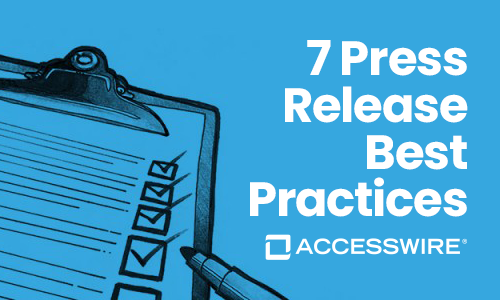How Long Should a Press Release Be?
When you set out to write an effective press release, there are a few key questions that you need to answer. The first of these questions is, What is it you want to say? The second question is equally important, but you may have a little more trouble answering—how do you best say what you want to say? To answer these questions, you have to think about the voice and tone. You also have to think about length.
So how long should a press release be?
While you likely know that the answer is longer than a fortune cookie and shorter than a novel, you may not know if there is a specific length you should be aiming to hit. Whether it is an announcement, product launch or a company event launch, an effective press release should be at least 300 words and max out around 400 words.1
What Determines the Ideal Length?
It’s easy to say that 300 - 400 words is the ideal length for any press release format, but it’s also important to understand why this length is ideal. There are a few factors that lead to this determination:
- People are pressed for time – It’s easy to think that people are too distracted, and that’s why they won’t read a long press release, but the truth is they’re busy. Journalists at various media outlets can get over 500 emails a day. You need to stand out, and you need to do it fast; otherwise, no one will pay attention.
- Information overload – There’s a temptation to include everything when press release writing so as not to forget any minor detail. But too much information puts the onus back on your reader to determine what’s important. Do that work for them. Give them only the relevant details, and they’re more likely to read what you have to say.
- Information underload – On the flip side, you don’t want to write a 20-word press release that explains nothing. No one is looking for coyness in a press release.
- Shows competence – If you write something too long, it sounds like you’re throwing anything against the wall to see what sticks. If you write too short, it sounds like you don’t have anything to say. 300 - 400 words give you time to convey any background information without overstaying your welcome.
- SEO – While you need to be concerned with having people read what you wrote, you also need to consider the internet. If your release is getting distributed through the internet, rather than appearing in a related article, you need it to be at least 300 words long. This is the cutoff where Google will index it, anything less will be ignored.
Structuring the Press Release
If we accept that 300 - 400 words is ideal, we’re still left with the question of how to get there. The basic press release format has a headline followed by three or four paragraphs. Let’s go over each to give you an idea of the ideal inverted pyramid press release structure.3
Headline
Time for some brutal honesty: many people won’t bother reading your full press release. Some won’t even get through the first sentence. However, everyone will read your headline. That means you need to make it good. This means you should also be asking yourself, How long should a press release headline be?
Some things to keep in mind:
- Many editorial systems will only show the first 55 characters of your press release headlines.
- Search engines only show the first 70 characters of a headline.
In other words, keep it short. Ideally, you should be shooting for a headline that is under ten words. In those ten words, you want to pique people’s interest so they will continue reading and convey basic information about what your release is about.
It’s not easy, but effective press release headlines can be the difference between getting your press release read and getting skipped over.
First Paragraph
Your headline baited your reader into opening your press release. Now it’s time to hook them.
That means there’s no time for a slow build. You need to introduce your reader to the story right away and make them want to know more. In fact, your first sentence should be that enticement all by itself. An ideal paragraph is about three or four sentences, so once you have that perfect first sentence, spend the rest of your first paragraph answering the 5Ws (and 1 H):
- Who
- What
- Where
- When
- Why
- How
Any good journalist knows that these are the most important questions to answer in any story. If you’re able to answer them in your first paragraph, you’ll have hooked your reader and given them the most pertinent information. even if this first paragraph is the only thing they read.
This is also a chance to work SEO. By putting keyword phrases early in the body of your media release, it is more likely to be seen in searches. But be wary not to pad purely for keywords, or your media release can become unreadable to actual humans.
Second Paragraph
You should spend most of your time working on your first paragraph. After all, that’s the part of your press release that’s most likely to be read. For the readers who choose to read beyond the first paragraph, you can now start fleshing out your story a bit.
But remember to avoid information overload, this section adds detail. but you don’t want to overwhelm. Some things to include:
- Supporting facts and statistics – Statistics go from interesting to overwhelming and boring very quickly. That means don’t overdo it with unnecessary facts. But, placing in some supporting evidence can boost your credibility in the eyes of the reader.
- Quotes – This is the perfect time to add some quotes. These can also help your credibility while adding a voice other than your own. Mixing things up like that will help keep readers engaged.
- Subheadings and bullet points – Anyone who’s read a classic novel can confirm that unbroken blocks of text can get overwhelming. Break things up with subheadings and bullet points to make information easier to digest and keep people reading.
This is the section of your press release where you may be tempted to go overboard. Remember to stick to relevant information and get to the point quickly. While an occasional topic may merit a third paragraph to convey the information, you typically want to keep your press release concise by including supporting facts in a paragraph that’s no longer than four sentences.
Conclusion
A closing paragraph can be used to summarize and reiterate your main points. However, you don’t want to get repetitive. Avoid the temptation to rewrite what you’ve already said. Instead, think of this as a reward for readers who reached the end where you can quickly condense all the information into a concise takeaway.
Boilerplate
You may be able to fold this into your concluding paragraph, or you may need it to be a paragraph all its own. This is where you can include all the pertinent information about yourself and your company. This is also the section where you should include contact details in case anyone wants to reach out for a follow-up.
Tips on Keeping Things Short
While you may struggle to get your press release to the 300-word mark needed for SEO, the much more likely issue you’ll find yourself facing is that your press release will be too long. Don’t worry. There are some methods you can use to help you find the ideal press release length:
- Write first, edit later – Don’t obsess over length. Write your press release first, then assess how much editing will be needed. Overfocusing on length can lead to disjointed and sloppy press release writing.
- Stick to what works – Write direct and to-the-point sentences. Write three to four sentences per paragraph. Write three to four paragraphs per press release. If you can stick to these guidelines, you’ll be coming in around the ideal press release length without needing much adjustment after the fact.
- A picture is worth a thousand words – Well, maybe not a thousand, but images can take the place of text. This can help keep your word count down and may be more engaging to readers. Plus, the reader’s eyes are naturally drawn towards pictures so your image will likely be seen.
Do you want to know if your press release was a success? Read our guide on press release analytics to learn how to measure its performance.
Get Your Press Release Seen with ACCESSWIRE
Trying to hit the perfect length in your press release can be frustrating, especially when you feel you have more to say, but you’re forcing yourself to cut words to hit a target. So why do we do it? To give us the best chance of getting our press releases read by our target audience.
Another way to ensure your press release is read is by working with ACCESSWIRE. Our press release distribution service gets your release seen by your target audience quickly and efficiently. We offer wide distribution at a flat fee to get your release in front of as many eyeballs as possible.
Crafting a press release that’s the perfect length is the first step. Working with ACCESSWIRE is what will ensure your press release crosses the finish line.
Sources:
Newswire. What Is the Ideal Press Release Length?
Forbes. What Journalists Really Think Of Your Press Release.
Pressfarm. The Best Press Release Length According to PR Gurus.
Flackable. How To Write A Great Press Release Headline That Stands Out.
Similar Blog Posts
PRODUCTS
ACCESSWIRE | All Rights Reserved




